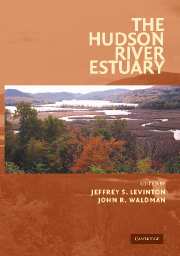Book contents
- Frontmatter
- Contents
- Preface
- List of Contributors
- The Hudson River Estuary
- 1 The Hudson River Estuary: Executive Summary
- GEOLOGICAL, PHYSICAL, AND CHEMICAL SETTING OF THE HUDSON
- PRIMARY PRODUCTION, MICROBIAL DYNAMICS, AND NUTRIENT DYNAMICS OF THE HUDSON
- HUDSON RIVER COMMUNITIES, FOOD WEBS, AND FISHERIES
- CONTAMINANTS AND MANAGEMENT ISSUES OF THE HUDSON RIVER ESTUARY
- 22 The History and Science of Managing the Hudson River
- 23 Hudson River Sewage Inputs and Impacts: Past and Present
- 24 PCBs in the Upper and Tidal Freshwater Hudson River Estuary: The Science behind the Dredging Controversy
- 25 Transport, Fate, and Bioaccumulation of PCBs in the Lower Hudson River
- 26 Contaminant Chronologies from Hudson River Sedimentary Records
- 27 Atmospheric Deposition of PCBs and PAHs to the New York/New Jersey Harbor Estuary
- 28 Toxic Substances and Their Impact on Human Health in the Hudson River Watershed
- 29 Impacts of Piers on Juvenile Fishes in the Lower Hudson River
- 30 Physiological and Genetic Aspects of Toxicity in Hudson River Species
- Index
- Plate section
- References
29 - Impacts of Piers on Juvenile Fishes in the Lower Hudson River
Published online by Cambridge University Press: 06 January 2010
- Frontmatter
- Contents
- Preface
- List of Contributors
- The Hudson River Estuary
- 1 The Hudson River Estuary: Executive Summary
- GEOLOGICAL, PHYSICAL, AND CHEMICAL SETTING OF THE HUDSON
- PRIMARY PRODUCTION, MICROBIAL DYNAMICS, AND NUTRIENT DYNAMICS OF THE HUDSON
- HUDSON RIVER COMMUNITIES, FOOD WEBS, AND FISHERIES
- CONTAMINANTS AND MANAGEMENT ISSUES OF THE HUDSON RIVER ESTUARY
- 22 The History and Science of Managing the Hudson River
- 23 Hudson River Sewage Inputs and Impacts: Past and Present
- 24 PCBs in the Upper and Tidal Freshwater Hudson River Estuary: The Science behind the Dredging Controversy
- 25 Transport, Fate, and Bioaccumulation of PCBs in the Lower Hudson River
- 26 Contaminant Chronologies from Hudson River Sedimentary Records
- 27 Atmospheric Deposition of PCBs and PAHs to the New York/New Jersey Harbor Estuary
- 28 Toxic Substances and Their Impact on Human Health in the Hudson River Watershed
- 29 Impacts of Piers on Juvenile Fishes in the Lower Hudson River
- 30 Physiological and Genetic Aspects of Toxicity in Hudson River Species
- Index
- Plate section
- References
Summary
abstract We examined the impacts of man-made structures, especially large piers, on fishes in the lower Hudson River, USA over a number of years. We used a multifaceted approach, and evaluated: 1) the distribution and abundance of fishes under piers, at pier edges, in pile fields, and in open water areas, 2) feeding and growth of young-of-the-year fishes (winter flounder, tautog, and Atlantic tomcod) under and around piers, and 3) availability of benthic prey for fishes under and adjacent to large piers. A review of our studies suggests that species diversity and species abundance were depressed under piers relative to nearby habitats. The only species that were routinely collected from under piers were those that do not appear to solely rely on the use of vision to forage (American eel, naked goby, Atlantic tomcod). Results from studies of the distribution of benthic invertebrate prey for fishes around piers suggest that prey abundances under piers are more than sufficient to support fish growth, however, results of directed growth studies indicate that feeding and growth rates of visually-feeding fish species (winter flounder, tautog) are negative under piers (that is, fish lose weight). It is not likely that factors associated with pier pilings, such as reduced flow or sedimentation, affect feeding, since studies of fish growth in pile fields (piers without the decking) indicate that fish grow well in that habitat. Rather, it appears that the decking associated with piers creates conditions of intense shading that impede foraging activities. We propose that under-pier areas, and potentially any areas that significantly reduce light penetration to depth in near shore areas, are poor habitats for fishes, and we urge careful consideration of shading effects prior to the construction, restoration, or renovation of over-water structures.
- Type
- Chapter
- Information
- The Hudson River Estuary , pp. 428 - 440Publisher: Cambridge University PressPrint publication year: 2006
References
- 7
- Cited by



